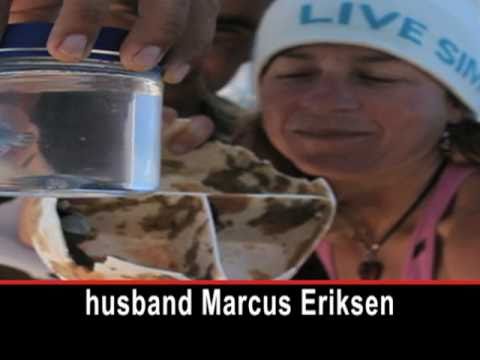Studying How Plastic Pollution Enters Ocean Food Supply
 |
From voaspecialenglish.com | facebook.com/voalearningenglish
Marcus Eriksen is not really fishing. He is catching plastic in the Atlantic Ocean. Eriksen wants to publicize the growing buildup of plastic waste in our oceans and to study its effects.
MARCUS ERIKSEN: "These are five sub-tropical gyres in the world where the majority of the plastic in the world accumulates."
ANNA CUMMINS: "The gyre is formed by ocean currents that couple with the spinning of the Earth, the Earth's rotation. And what happens is that you have, effectively, a massive whirlpool, this large spinning system, where debris can accumulate."
Anna Cummins and her husband Marcus Eriksen set up a not-for-profit group called the 5 Gyres Institute. It helps researchers with studies of plastic pollution in the oceans. Cummins says plastic bags and bottles have little or no value after they are used. Most plastic waste can be found in solid-waste landfills or along rivers. A lot of this waste also washes out to sea.
ANNA CUMMINS: "This becomes a problem in the marine environment because plastics are designed to last forever. They don't break down, they can't be digested by marine organisms and they persist in the ocean for thousands of years."
When sailing, Eriksen and Cummins gather objects from the ocean's surface. Hundreds of things they caught have gone to a California laboratory for testing.
ANNA CUMMINS: "What shocked me the most on all these trips is to cross an ocean, to cross for thousands and thousands of miles, and find that every single sample we pull up has plastic."
Some plastics stay in large pieces for a long time. But many break down into smaller particles.
ERIKSEN: "The plastic out there. It's not a condensed island of trash. It's really spread out. And it's this plastic soup, that is from continent to continent."
Animals mistakenly eat the smaller pieces of plastic or feed them to their young.
ANNA CUMMINS: "Roughly 43 percent of all marine mammals, 86 percent of all sea turtle species and 44 percent of sea bird species have been found with plastics in or around their bodies. Thirty-five percent of the samples of fish that we collected in the north Pacific had plastic in their stomachs."
5 Gyres Institute and its partners are now studying how plastics enter the ocean's food supply and their effects on human health.
ANNA CUMMINS: "I had a chance to do what's called a 'body burden analysis' on my own blood. We looked into my blood serum to find, do I have the same chemicals that we know stick to plastic. And we found in my blood trace levels of PCBs, DDT, PFCs and higher levels of flame retardants. We don't know how these chemicals entered my body. As a woman, I know that these chemicals in my body will pass on to the next generation."
Marcus Eriksen and his partners used 15,000 empty plastic bottles to build a boat they called "JUNKraft." In 2008, they sailed from California through the North Pacific Gyre.
MARCUS ERIKSEN: "The North Pacific Gyre, it's surprising if you go only 1,000 miles off the coast of California, which is 7,000 miles from Japan, you still get a lot of Japanese and Chinese plastic."
Eriksen and Cummins say the seas of plastic waste will be with us for a long time. But they believe there are solutions.
MARCUS ERIKSEN: "The solutions, they don't begin on the ocean. They begin on land."
ANNA CUMMINS: "We also need to improve our recycling infrastructure. Here in this country, in the United States, we only recover and recycle roughly five percent of our plastics."
Re-using plastics is one way. The husband and wife team say they support the wider use of biodegradable materials. They want more products re-designed so they can be used again and again. And they believe that people around the world need to understand the problem of plastic waste and its effect on the environment and our health. I'm Shirley Griffith.
|




